FOA Newsletter - Features
2013 - The Year In Review (Continued)
CATV vs OTT
Here in the US last year, the Time Warner and CBS battle over fees finally drove many CATV subscribers - us included - to cancel subscriptions. When a CATV company thinks it can hold its subscribers hostage for over a month while fighting their own pricing battles, they are delusional.
And when I chaired a panel on gigabit broadband at a independent telco/ISP convention, within 5 minutes the discussion moved to the "greedy content providers" charging so much that providers could not make money from delivering content - all agreed that OTT was the solution. (OTT means "over the top," referring to video content directly downloaded, not watched from a service provider's own content.
Later in the year, at another meeting I was asked about how to structure FTTH services to a very large apartment complex being built. After we discussed the technical aspects, the developer started complaining about the cost of TV content and how it seemed impossible to compete with CATV or to make a profit off it. I told him the stories from the previous two paragraphs and suggested he consider offering higher speed Internet (at a reasonably higher price) and tell the users to go OTT.
BTW, I had one of the world's first cable modems - February 1997, 17 years ago - and I paid $40/month for 2Mb/s. When I cancelled my cable subscription, I was paying $60/month for no faster service in the afternoon and evening because Time Warner Cable had severe system overload and speeds dropped by over 90%. Where is the investment in infrastructure?
And who believes that mobile viewers will watch TV on a schedule? That's delusional too. It will be totally OTT.
In the late 90s at COMNET, I said that telcos were perhaps the "railroads of the 21st century"* which made me a pariah among telcos. But I may have been wrong - perhaps it is the cable companies! (* In the US, railroads were unable to understand and keep up with changes in transportation so they faded into nothingness...)
And then, an installer was recently fired from a CATV contractor crew because he 1) wanted to splice all 6 fibers in a closure instead of the 2 he was told to do, 2) wanted to prefab the closure and banjo fittings before going to the worksite to make the field work faster and 3) wanted some traffic control after nearly being hit several times when splicing on a roadside. His opinion was every decision was based on microscopic cost analysis and none of the higher-ups knew anything about fiber.
The Cloud
Last July in the newsletter, we talked about "The Cloud" and how it is being hyped as the next big thing. But we wondered if those pushing it so hard were aware that it will require more speed for ISP connections. We keep asking this question but nobody seems to have an answer! It's in the same category as our question about CATV companies investing in service expansion.
Mobile Internet Traffic Continues to Grow
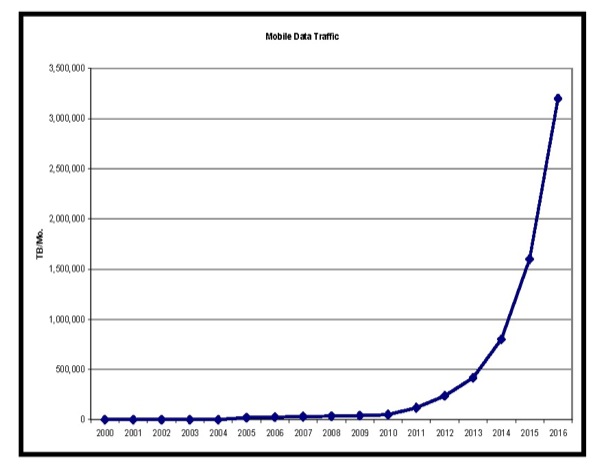
From IGI Consulting Network Traffic Forecast and Analysis – 2013-2017
But In The US: U.S. Struggles to Keep Pace in Delivering Broadband Service (NY Times)
A few quotes:
"The United States, the country that invented the Internet, is falling dangerously behind in offering high-speed, affordable broadband service to businesses and consumers, according to technology experts and an array of recent studies."
"The Obama administration effectively agrees. “While this country has made tremendous progress investing in and delivering high-speed broadband to an unprecedented number of Americans, significant areas for improvement remain,” said Tom Power, deputy chief technology officer for telecommunications at the White House." (You can read a White House Report on broadband here.)
"The World Economic Forum ranked the United States 35th out of 148 countries in Internet bandwidth, a measure of available capacity in a country. Other studies rank the United States anywhere from 14th to 31st in average connection speed."
"Some American cities have such superfast broadband that if they were ranked against foreign countries, several, like Bristol, Va., Chattanooga, Tenn., and Lafayette, La., would rank in the top 10. Those three cities built municipal fiber-optic networks, and those networks can operate just as fast as the swiftest connections in Hong Kong, Seoul and Tokyo. But those speeds can come at a very high price. In Chattanooga, Internet service of 1 gigabit a second costs a consumer $70. But in Lafayette, the same speed costs nearly $1,000 a month. In Seoul, it’s about $31 — a result of government subsidies to encourage Internet use."
Chuckle of the month: At the recent FTTH Council Meeting in Austin, TX, Mark Strama, head of Google Fiber in Austin, made the comment "there's no Moore's Law for the Internet" - straight out of the FOA Newsletter in July 2013 (What's absolutely certain is that the Internet does not follow "Moore's Law" for computers!)
What Does The International Telecommunications Union Say?
A lot! They have already released their annual publication Measuring the Information Society 2013 which has 200+ pages of graphs, tables and analysis of the world telecommunications systems, with detailed graphs like this:
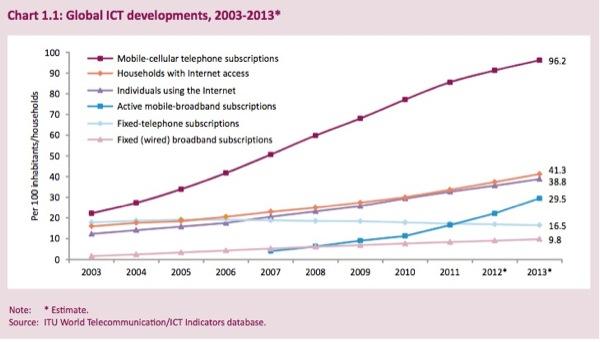
Download your own copy and set aside time to review it - you won't be disappointed.
Forecasts For 2014?
Not on your life! Our "time machine only goes back in time!" I always think about a quote from Ollie Wight, the IBMer who developed MRP (materials requirements planning - the basis of all automated production control systems) who taught a class I took on forecasting. He liked to say "All forecasts are wrong, from the moment they are made!" So my preference is to get on the time machine and go back, but avoid trying to mess with the laws of physics and try to go forward.
However, we will tell you that the FOA will be introducing our new OLAN specialist certification and soon a new "application specialist" certification aimed at network owners, designers and users.
Not everybody avoids forecasting! You can watch Lightwave's Webinar "Carrier Trends for 2014" here.
FOA Continues Growing Worldwide
FOA certified a record number of CFOTs and CPCTs in 2013. We've now certified over 45,000 techs that are working worldwide to build the fiber networks that make commumications work! Great job everyone!

Rolls Royce Expands Fiber Optic Workforce 25% For Fiber Optic Headliner
According to the NY Times in their review of the new Rolls Royce Silver Wraith, the new $372,324 2014 Rolls-Royce Wraith coupe is selling well, "But the signature feature is the Wraith’s Starlight Headliner, consisting of 1,340 LEDs hand-sewn to create an effect of owning one’s personal night sky filled with stars, the luminosity controlled by the driver.

“Because each optical fiber is cut by hand at a slightly different depth, each star has its own intensity,” said Phil Harnett, the Wraith’s product manager. “So it looks like a real night sky.”
The made-by-hand feature takes four days, and though it is the Wraith’s most expensive stand-alone option at $12,925, it is one of the most popular. “Due to demand, we had to look for another poor unfortunate soul to help the four guys who are doing the work,” Mr. Harnett said.
How can the workers building a $372,324 automobile be "poor, unfortunate souls"?
New Free Fiber U Optical LAN (OLAN) Self-Study Program

FOA has added a new Fiber U self-study program on Optical LANs (OLANs). As you know, this is a hot topic in the IT world, so FOA has created an online course that allows you to study about OLANs (FOA includes fiber to the desk, fiber to the office and passive optical LANs) on your own time and schedule. You will be guided to material to read, videos to watch and even have quizzes to check your comprehension.
All Free!
OLANs on Fiber U

New Pages in the FOA Online Fiber Optic Reference Guide
The page on Optical LANs (OLANs) has been expanded to 5 pages with new material and links.
What do you do when you need to test fiber or cable on a reel? Here is a new page on Bare Fiber Testing
Couplers or splitters are used in FTTH and OLANs. How do you Test Splitters?
Tapping fiber has become a big topic in the news. How do you tap fiber?
What's A Network? A simple explanation of network types and operation has been added to the FOA Online Guide.
We have updated the "Datalinks" page
OLANs - Optical LANs
FOA OLAN Certification Released
OLANs are probably the most important new technology for enterprise networks since the introduction of structured cabling standards 22 years ago. For the last few months, FOA has been working with companies and groups interested in OLANs to create a certification for techs designing and installing them.
With OLANs, FOA has worked with leaders in the field to create technical materials on our FOA Guide website, Fiber U self-study program and YouTube channel already. We now have a curriculum ready our FOA-Approved schools which will make OLAN training available for those interested. Read More.
New Photos: San Diego Opens New Central Library With Optical LAN
Tellabs has also posted a number of very interesting videos on the library.
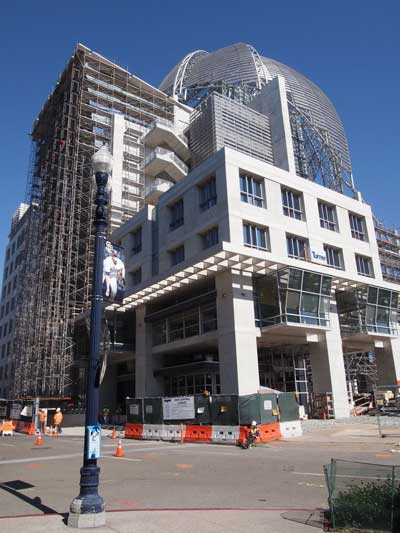
OLAN Resources
Over the last couple of years, we've written a lot about Optical LANs, either based on FTTH passive optical network (PON) or point-to-point (P2P) Ethernet architecture. The more we see of these types of networks, the more we appreciate their design and economy. But how about scale - how big can they get?
In November, we ran a picture story about the new San Diego Central Library which is using a Tellabs optical LAN using PON technology that was using about 1000 4 port drops. Now we hear another Tellabs customer has over 16,000 users. That must make it one of the biggest LANs in the world.
Here are more sources of information on optical LANs - BTW, they need a name - let's start calling them OLANs!
FOA Guide Page on OLANs and FOA YouTube Video
Tellabs
Motorola/ARRIS
Cliff Walker's FTTO paper
3M on POLs
TE Connectivity
APOLAN, trade association for Optical LANs website http://www.apolanglobal.org/

New FOA YouTube Videos
Fiber Optics "Live"!
Working with fibers the size of the human hair and light invisible to the human eye makes fiber "mysterious" and hard to understand. Drawings on how things like fiber work can provide a level of understanding, but nothing beats seeing it for yourself. After a lot of experimenting, we have come up with one solution that allows us to demonstrate how fiber works via "total internal reflection," how fiber attenuation is caused by scattering and how it is dependent on wavelength and how connector loss happens.
Want to see how fiber works? Look at this:
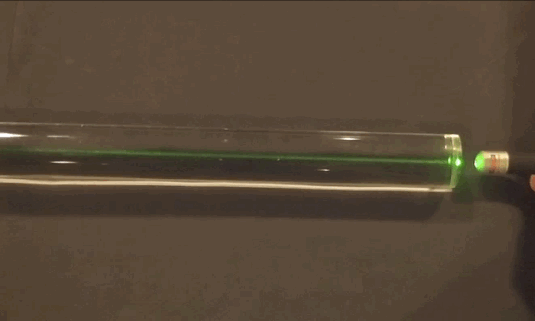
The secret to making it visible is to use a green laser pointer instead of the more common red one. In the plastic rod we used to simulate optical fiber, the scattering of the green laser pointer is much higher than the scattering of a red laser pointer, making it much more visible. This is, of course, exactly what we teach students - longer wavelengths of light (redder, right?) have less scattering and therefore less attenuation.
Using this simple idea, we have created three new YouTube video demonstrations we call "Fiber Optics - Live." You can view them here:
How Light Travels In A Fiber
Fiber Attenuation
Connector Loss
If you teach communications or IT to high school or younger students, you can use these videos to show how fiber works and, if you are interested, duplicate these experiences in your classroom.
Where Are The Jobs In Fiber Optics?
Watch the new FOA YouTube Video: Where Are The Jobs In Fiber Optics?

FOA gets lots of calls and emails from our members looking for information about where the jobs are and how to train for them. FOA has created three ways to help you find jobs, train for them and apply for them.
Where Are The Jobs In Fiber Optics?
FOA has created a 20 minute YouTube video that talks about all the applications for fiber optics, what jobs are involved and the qualifications for the workers in the field. Besides telecom and the Internet, we cover wireless, cable TV, energy, LANs, security, etc. etc. etc. It's a quick way to get an overview of the fiber optic marketplace and we give you an idea of where the opportunities are today. Watch the new FOA YouTube Video: Where Are The Jobs In Fiber Optics?
FOA has these pages on jobs, how to get trained and how to find them:
FOA's guide to jobs
What Training And Certifications Are Needed For Jobs In Fiber Optics?
Cabling Project Management - FOA has created a new YouTube video on what's involved in a cabling (copper/fiber/wireless) project with advice for both the customer and the contractor involved in a cabling project. The intent of this video lecture is to help customer and contractor communicate effectively on a new project.
Read more
Three Good Practice Tools For OTDRs, All Free
FOA OTDR Simulator
You may already know that the FOA has a free OTDR Simulator you can download from our website (go here for directions) that allows you to practice using an OTDR on your PC, seeing the effects of changing setup parameters and analyzing dozens of real world traces. But here are two more tools that can be good for practice.
AFS OTDR Online Demo
AFS has an online interactive demo of their new OTDR that allows you to see how an OTDR makes measurements. You use the yellow buttons in the center of the OTDR to set the markers to make measurements. Very well done. Go to http://www.afsi.us/otdr/otdr_mode.php for the demo.
Fiberizer OTDR App Available Free as "Cloud Service"
Fiberizer Cloud – fiber optic testing data management solution in the cloud.
The new web service Fiberizer Cloud was developed from the view point of ordinary fiber optic engineers and their businesses. Now engineers have no need to store multiple copies of their OTDR traces on different PCs in tremendous number of nested folders; or to order expensive custom software. Fiberizer Cloud allows to store and analyze fiber optic testing data directly from the browser .
Currently Fiberizer Cloud registration is free and available here: http://fiberizer.com
YouTube video on Fibrizer: (http://www.youtube.com/watch?v=JRiTVDSEaug)
"Fiberizer" APP Reads, Analyzes OTDR Traces
Fiberizer is a iPhone/iPad APP that reads industry-standard ".sor" format files and allows trace analysis on your iPhone or iPad. An android version is in the works too. Read more about Fiberizer. And here are more directions on its use.
OTDR FAQs
Including FOA Master Instructor Terry O'Malley's tests on what the end of a fiber trace looks like with broken and cleaved fibers.
Frequently Asked Questions On OTDRS And Hints On Their Use
RETURN TO INDEX
Events of Interest

Lightwave Says "Passive Optical LANs Catch Fire*", Offers Free Webinar - WATCH ANYTIME
Here is the announcement and link to sign up.
With bandwidth demands on enterprise networks increasing, network managers have begun to rely more heavily on fiber. Passive optical local area networks (LANs) have emerged as a particularly strong option for building and campus applications as a future-proof way to meet very high bandwidths today or to ensure an smooth evolution toward future all-fiber enterprise networks.
This special webinar by Lightwave again confirms the rising popularity of Optical LANs (OLANs) based on FTTH technology and emphasizes the importance of the new FOA OLAN training and certification.
*If you are not fluent in English slang, that means it's "hot" or very popular!

See the Light® Fiber Optic Training Program
Webinars, seminars and certification training classes.

You are invited to join JDSU for a complimentary series of educational webinars. Each webinar, presented by a JDSU subject matter expert, lasts approximately one hour, including Q&A. Seminars are on Connectivity (May 23), Testing Fundamentals (June 20) and OTDRs (July 11)
Go here to see the seminars offered.
Don't forget to download your copies of the JDSU Testing Textbooks.
RETURN TO INDEX
 What's Happening @ FOA What's Happening @ FOA

FOA has three LinkedIn Groups
FOA - for FOA members only, covers technology and jobs in the fiber optic marketplace
FOA Fiber Optic Training - open to all, covers fiber optic technology and training topics
FOA School Instructors - a closed group for instructors and administrators at FOA-approved schools
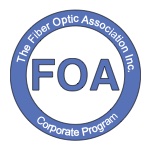 Corporate Memberships Corporate Memberships
FOA is now offering corporate memberships to companies involved in fiber optics as manufacturers, contractors, installers, etc. Among other benefits, Corporate Membership gives companies access to special FOA materials for educating customers and employees. Read more.
FOA Standards:
FOA now offers free standards for datalinks and testing the installed fiber optic cable plant, patchcords and cable, optical power from transmitters or at receivers and OTDR testing.
Available for comment is a new proposed standard for Datalinks.
Look for the "1 PageStandard" web page and in the FOA Online Reference Guide.
Go to the FOA "1 Page Standards"
Free For FOA Members: NECA/FOA 301 Fiber Optic Installation Standard
Because of its importance to users, contractors and installers of fiber optic networks, The FOA and NECA have agreed to make the NECA/FOA 301 Fiber Optic Installation Standard available free to FOA members. It's specifically written to be used in contracts to define "installation in a neat and workmanlike manner." FOA members can go here for instructions on how to download your free copy.
FOA is a member of:



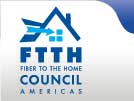
NECA/FOA 301 Installation Standard
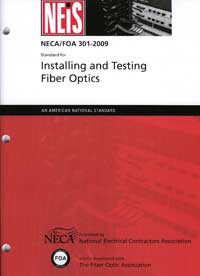
Standards cover components and systems and how to test them, but rarely get into installation issues. The FOA NECA 301 standard which covers installation of optical fiber systems has been revised for the second time, adding considerable new materials. This standard is derived from FOA educational material put in standards form and approved by ANSI as an American National Standard. It's specifically written to be used in contracts to define "installation in a neat and workmanlike manner." The standard is available from NECA. FOA members can go here for instructions on how to download your free copy.
RETURN TO INDEX
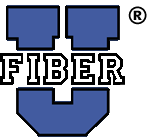
Free Fiber U Self-Study Programs
FOA'S "Fiber U" free online self-study programs help you learn about fiber optics, study for FOA certifications or use them to help create "blended learning" classes. There are two new free online self-study programs on Fiber U. Fiber Optic Network Design is for those interested in learning more about how to design fiber optic networks or studying for the CFOS/D certification. FTTx is for those wanting to know more about fiber to the "x" - curb, home, wireless, etc. - or studying for the CFOS/H certification.
Got to Fiber U for more information.
Lennie & Uncle Ted Now Available As Free Books on iTunes
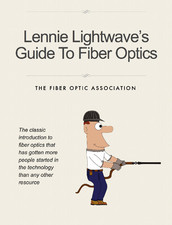 
Lennie Lightwave's Guide to Fiber Optics and Uncle Ted's Guide To Premises Cabling are now available free to iPad users who can download them from the Apple iTunes store.
Lennie's Guide has always been the world's favorite introduction to fiber optics. It was first published in the mid-1990s by Fotec, the fiber optic test equipment company famous for its "Fiber U" training conferences and more than 60,000 printed copies were distributed. Lennie was one of the earliest commercial webpages and is still online today (and as popular as ever) at http://lennielightwave.com. Uncle Ted's Guide was created at the request of Lennie readers who wanted a similar simple introduction to "Cat 5" wiring. This latest version of Uncle Ted's Guide covers the all premises cabling topics - wiring, fiber and wireless.
You can find these free guides on Apple's iTunes Store: Lennie Lightwave's Guide to Fiber Optics and Uncle Ted's Guide To Premises Cabling
- Reference Books for FOA Certifications available on Kindle and iPad/iPhone as well as printed
  
We have created three new FOA books to be used in training for FOA certifications and as reference books for contractors, installers and end users of fiber optics. These books have full curriculum support, including free curriculum materials for teaching FOA certification courses. Because we are self-publishing these books using more modern "publish on demand" technology, they are easier to keep up to date, easier to buy and much, MUCH cheaper!
All are now available in print and electronically in Kindle and Apple iBook versions. The basic fiber optic book is also available as a self-study program in an Apple APP for iPad/iPhone/iPod.
Details on the new book each of the new books are at the book pages linked to the photos above.
RETURN TO INDEX
FOA iPad Apps
The FOA has just released its second APP for the iPad, a free "loss budget calculator," FOA LossCalc.
FOA LossCalc
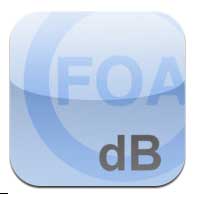 FOA LossCalc estimates the optical loss of a fiber optic link. This will save time for the installer of a fiber optic link needing to know whether test results are reasonable and/or make a "pass/fail" determination. It can also help the designer of a link to determine if communications equipment will operate over this link. FOA LossCalc estimates the optical loss of a fiber optic link. This will save time for the installer of a fiber optic link needing to know whether test results are reasonable and/or make a "pass/fail" determination. It can also help the designer of a link to determine if communications equipment will operate over this link.
By choosing the type of link (singlemode or multimode) and specifying the length of the fiber and numbers of connections and splices, it will calculate the end to end loss of the link. The app has default specifications for singlemode and multimode links or the user may create custom setups with specifications appropriate for any application. http://itunes.apple.com/us/app/foa-losscalc/id476262894?mt=8&ls=1
Self -Study in Fiber Optics
 Our first app is a self-study version of the FOA Reference Guide to Fiber Optics. The FOA APP builds on the FOA basic fiber optic textbook to create an interactive learning environment that builds on the iBook electronic version of the book to add a guide to use for self-study and real-time testing that provides feedback on what you have learned and correct answers to questions answered incorrectly. Our first app is a self-study version of the FOA Reference Guide to Fiber Optics. The FOA APP builds on the FOA basic fiber optic textbook to create an interactive learning environment that builds on the iBook electronic version of the book to add a guide to use for self-study and real-time testing that provides feedback on what you have learned and correct answers to questions answered incorrectly.
The FOA APP is priced at only $9.99, same as the iBook, so the self-study program is free. Download it from the Apple APP Store with your iPad or iTunes.
http://itunes.apple.com/us/app/foa-guide/id434354283?mt=8&ign-mpt=uo%3D4
More "Quickstart Guides"
In our continuing quest to help people understand how to test fiber optic cable plants and communications systems, we've created two more "QuickStart Guides to Fiber Optic Testing." They are simple, step-by-step guides on how to test fiber optic cable plants, patchcords or single cables using insertion loss or OTDR techniques and optical power from transceivers. It's as straightforward as it can get - what equipment do you need, what are the procedures for testing, options in implementing the test, measurement errors and documenting the results.
It can't get much simpler.
Send anybody you know who needs to know about fiber optic testing here to learn how it's done in a few minutes.
Testing Fiber Optic Cable Plants And Patchcords
Testing Fiber Optic Cable Plants With An OTDR
Measuring Optical Power In Communications Systems
RETURN TO INDEX

The FOA has many videos on YouTube, including two Lecture Series (Fiber Optics and Premises Cabling), Hands-On lectures on both and some other informational and instructional videos. For all the videos, go to the FOA Channel "thefoainc" or use the direct links below.
New FOA Lectures And Hands-On Videos
Where Are The Jobs In Fiber Optics? FOA talks about all the applications for fiber optics, what jobs involve and the qualifications for the workers in the field.
Prepolished/Splice Connector Termination (Panduit OptiCam)
Cabling Project Management - what's involved in a copper/fiber/wireless project -advice for the customer and the contractor
Hazards Of Counterfeit Cable
You may have read the stories we have written about the counterfeit "Cat 5" cable made from copper-clad aluminum rather than pure copper. Recently we tried an unscientific burn test on the cable compared to a known good UL tested cable and posted a video on YouTube. You can see the results below.
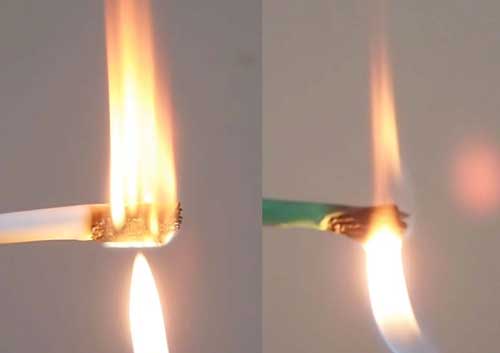
Counterfeit Cable Real UL-rated cable
The difference is obvious and the danger is real. Watch the video on YouTube: Premises Cabling Lecture 11: Counterfeit Cat 5 Cabling
2 New "Hands-On Hints" Videos:
Using an OTDR
Visual Inspection of Connectors With A Microscope
Below is a list of all the current lectures and hands-on videos. We're looking for ideas for topics for future lectures. Send your ideas to <info@thefoa.org>.
Hands-On Fiber Optic Videos show how it's actually done
Using an OTDR
Visual Inspection of Connectors With A Microscope
Fiber Optic Connector Polishing Technique
Prepolished Splice Connector Termination (Unicam)
Prepolished/Splice Connector Termination (Panduit OptiCam)
The Fiber Optic Tester In Your Pocket (Cell Phone)
Insertion Loss Testing
Fusion Splicing
Mechanical Splicing
Fiber Optic Termination, Part 1, Setup & Tools
Fiber Optic Termination, Part 2, Jacketed Cable Prep
Fiber Optic Termination, Part 3, Adhesive Prep
Fiber Optic Termination, Part 4, Stripping Fiber
Fiber Optic Termination, Part 5, Connector Attachment
Fiber Optic Termination, Part 6, Polishing
Fiber Optic Termination, Part 7, Inspection
Fiber Optic Termination, Part 8, Distribution Cable Termination
Fiber Optic Cable, Part 1 Introduction
Fiber Optic Cable, Part 2, Zipcord
Fiber Optic Cable, Part 3 Distribution Cable
Fiber Optic Cable, Part 4 Breakout Cable
Fiber Optic Cable, Part 5 Loose Tube Cable
Fiber Optic Cable, Part 6, Armored Cable
Lectures On Premises Cabling
The FOA has added more videos to our YouTube Channel, thefoainc. These are an introduction to premises cabling, covering applications, types of cabling, standards and installation practices for copper (UTP and coax), fiber and wireless. Like our lecture series on fiber optics, these provide a comprehensive introduction to the subject in short videos, typically 5-10 minutes in length, on each subject. Watch for more.
Premises Cabling Lectures on YouTube
"Hands-On" UTP Cabling Videos show how it's actually done
UTP "Cat 5" Cabling, Part 1, Tools
UTP "Cat 5" Cabling, Part 2, The Training Board
UTP "Cat 5" Cabling, Part 3, UTP Cable
UTP "Cat 5" Cabling, Part 4, 66 Block Punchdown
UTP "Cat 5" Cabling, Part 5, 110 Block Punchdown
UTP "Cat 5" Cabling, Part 6, Jacks
UTP "Cat 5" Cabling, Part 7, Testing
UTP "Cat 5" Cabling, Part 8, Plugs and Patchcords
Lectures On Instructor Training
A new section of the FOA YouTube channel is all about teaching fiber optics and premises cabling. It's designed to help instructors working toward FOA CFOS/I instructor certification but is also useful to anyone teaching fiber or premises cabling.
FOA Instructor Training and Certification Playlist (all videos)
FOA Instructor Training - Part 1 -Introduction
FOA Instructor Training - Part 2 - About The FOA
FOA Instructor Training - Part 3 - FOA Approved Schools
FOA Instructor Training - Part 4 - Instructors
FOA Instructor Training - Part 5 - Curriculum
FOA Instructor Training - Part 6 - Teaching A Course
FOA Instructor Training - Part 7 - Hands-On Labs
FOA Instructor Training - Part 8 - FOA Resources
View all the FOA YouTube video Lectures.
RETURN TO INDEX
What's New in the FOA Online Fiber Optic Reference Guide?
We have been updating the Online Reference Guide to keep up with changes in the industry and adding lots of new pages of technical information.
What do you do when you need to test fiber or cable on a reel? Here is anew page on Bare Fiber Testing
Couplers or splitters are used in FTTH and OLANs. How do you Test Splitters?
Tapping fiber has become a big topic in the news. How do you tap fiber?
The page on Optical LANs (OLANs) has been expanded with new material and links.
What's A Network? A simple explanation of network types and operation has been added to the FOA Online Guide.
We have updated the "Datalinks" page.
Three new "Quickstart Guides" for fiber optic testing: cable plant & patchcord loss, power and OTDR
Learn More About OTDRs - Download a Free OTDR Simulator
More and more installers are being asked for OTDR testing but using these instruments is not easy. They are hard to set up properly and complicated to interpret the traces. Using the autotest function can lead to disastrous results! The FOA has a good tutorial on OTDRs on our Online Reference Guide and we added a free download of an OTDR simulator to the OTDR section so you can learn how to use an OTDR on your PC.
More New Info:
Links to manufacturers and distributors of fiber optic lighting products.
The FOA Online Fiber Optic Reference Guide has become very popular - perhaps the most popular technical website ever, typically with over 360,000 users downloading about 1.75 million pages in 2011! We continue updating materials regularly, keeping it as up to date as possible.
Find What You Want Using "Google Custom Search
 There's so much information on the FOA Tech Topics and Online Fiber Optic Reference Guide that even a well-organized Table of Contents isn't enough and when the material is always changing, an index is impossible to maintain. So the FOA is using the latest technology in search, Google Custom Search, which will allow you to search just the FOA Tech Topics and Online Fiber Optic Reference Guide for any topic you want to find more about. Try it! There's so much information on the FOA Tech Topics and Online Fiber Optic Reference Guide that even a well-organized Table of Contents isn't enough and when the material is always changing, an index is impossible to maintain. So the FOA is using the latest technology in search, Google Custom Search, which will allow you to search just the FOA Tech Topics and Online Fiber Optic Reference Guide for any topic you want to find more about. Try it!
Go to The FOA Online Fiber Optic Reference Guide.
RETURN TO INDEX
School News
We always enjoy feedback, especially when it shows how great some FOA instructors are. This came from a student of Tom Rauch, an instructor at BDI Datalynk:
"Thanks to our tremendously knowledgeable and patient instructor Thomas Rauch, who was not only generous in sharing his wealth of information, but he did so with ease, humor and in a way that invited curiosity and participation. He was encouraging and proud of our accomplishments and helped us learn from our mistakes in a way that did not break our confidence, rather it pushed us to better results the next go around. The hands on labs were just AWESOME!" Just thought you should know what a class act you have representing you in his travels..... but then again you probably already knew that! : )
In almost 19 years at Verizon and having held numerous positions, I have gone through many training sessions. I cannot remember ever having been actually looking forward to coming back to class quickly after lunch, to get back to the hands on activities, and walking away with the sense of empowerment that the information presented was not only relevant but dead on point accurate! I will be signing up for the Outside Plant class on March! I can't say enough good things about Tom and his impact! Feel free to quote me, I can only imagine that he will open so many doors and change so many lives in the years to come, with his style of teaching! Great experience, awesome job!"
IBEW and FOA Partner on Fiber Optic Training
The International Brotherhood of Electrical Workers (IBEW) and the National Electrical Contractors Association(NECA) through the National Joint Apprenticeship and Training Committee (NJATC) in a partnership with the FOA has published a new textbook for training IBEW apprentices and journeymen in fiber optics. The new textbook uses the material from the FOA Reference Guide To Fiber Optics with new material and photos from other NJATC training partners.
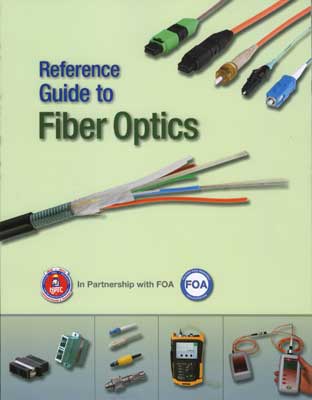
FOA is pleased to have been able to assist the NJATC in the development of this new text. FOA has been a NJATC training partner for many years, including offering instructor training at more than 16 of the NJATC's summer National Training Institutes. A majority of IBEW NECA contractors do fiber optics and low voltage, especially for applications that combine electrical and communications cabling like smart grid, alternative energy, traffic controls, data centers, etc.
Quote from one of our certified instructors: I want to thank you and your organization for all the resources you provide for the students and the opportunity to offer the certification to the students. The fact that you published the book yourself to get the cost down and the unlimited free resources on your website shows a commitment to the public that is second to none. I let it be known to the students that the FOA is the best in the industry at supplying knowledge and resources related to the communication industry. I look forward to passing on the information that you provide for the industry.
Great Video About An FOA School And Their Training
BDI Datalynk trains at the Unversity of Central Florida. UCF created this incredible video on the BDI Datalynk program. It shows the power of what they offer on campuses around the US.
Watch the video here: http://www.ce.ucf.edu/Program/2583/Fiber-Optics-Network-Certification-Courses-Non-credit/
For more information, contact Bob Ballard, CFOS/I, BDI DataLynk, LLC, A Vietnam Veteran-Owned Company
www.bdidatalynk.com, Ph: 512-785-9024
New Schools
The FOA welcomes the newest additions to our listing of FOA-Approved Training Organizations:
Brent West, NIECT, Portland, Oregon
(JATC training available to IBEW/NECA members only)
FOA Approved School # 627
Find a listing of all the FOA-Approved schools here.
It's Now A Lot Easier To Find A FOA-Approved Training Organization

Most phone calls we get regarding finding a FOA-Approved training organization want to know two things: what school is closest to me or what school offers the certifications I need. That can be difficult, since the FOA has almost 200 training organizations we have approved worldwide!
We've been looking at ways to make it easier, and we think we've got a good solution. In fact we have two solutions.
First we have added a sortable table of all the FOA-Approved schools.
You can also use our FOA Google Map Application to find FOA-Approved schools.
Here are links to the sortable table of all the FOA-Approved schools and FOA Google Map.
What Should A Fiber Optics or Cabling Tech Know and What Skills Do They Need?
The FOA has been updating its lists of KSAs (Knowledge, Skills, Abilities) for fiber and cabling techs. The updated list is now on the website for your information and comments - as fiber and cabling KSAs evolve as new technologies develop.
KSAs for fiber and cabling techs.
RETURN TO INDEX
Good Question! Tech Questions/Comments Worth Repeating
Fiber IN The Home?
Q: I am or was about to run Cat6 Ethernet cable through my house. Granted it would do the job. Having come across your organisation and brilliant website, I have started to think about a fibre install. Could you help with some suggestions as I find the difference between cables confusing.
A: Certainly you can install fiber in your home. See Fiber Optics in Premises Cabling. Best choice would be 50/125 multimode fiber, type OM2 or OM3. But to connect devices you will need media converters (Media Conversion) which will convert from fiber to the Ethernet ports designed for Cat 6. Fiber makes a nice showcase but is overkill for most homes.
Older Fiber?
Q: I have some 62.5 mm and sm inside fiber plant over 20 years old. When is a good time to upgrade?
A: When you need to or have to. If it's working OK, there is no need to upgrade!
Time Of Flight Testing
Q: Is there test equipment in the market that can do latency test (time of flight) on fiber optic cable? I have the formula for the calculation, Distance x Refraction Index / Speed of Light. Is there test gear to prove that we have met or are close to meeting the specs?
A: Use an OTDR. Measure the distance and use the index of refraction programmed into the OTDR to make the calculation of time of flight.
"Connector Loss" or "Connection Loss"
Q: I have always counted the loss of a connector as .75 dB (568B-3) and 1.5 for a mated pair. Is that correct?
A: While the industry always says "connector" loss, it is actually "connection" loss. As we explain in the page on termination and splicing (http://www.thefoa.org/tech/ref/basic/term.html) When we say "connector" loss, we really mean "connection" loss - the loss of a mated pair of connectors, expressed in "dB." Thus, testing connectors requires mating them to reference connectors which must be high quality connectors themselves to not adversely affect the measured loss when mated to an unknown connector. This is an important point often not fully explained. In order to measure the loss of the connectors you must mate them to a similar, known good, connector. When a connector being tested is mated to several different connectors, it may have different losses, because those losses are dependent on the reference connector it is mated to."
The TIA spec of 0.75dB is for a mated pair of connectors. If you have been passing connectors tested @ 1.5dB loss....you may have some very bad connectors in your cabling!
Changing From OM2 to OM3/4 Fiber
Q: We have a system currently that is comprised of OM2 fibre with LED transceivers. There is a proposal to change the fibre to OM3 and I have been asked to look at how the change will affect the transceivers currently fitted which will remain the same until a later upgrade. From looking around on various forums I can see that OM3 is optimised for lasers, however the existing hardware will remain as LED. My understanding is that OM3 is simply fibre manufactured to a better standard than OM2 with significantly less internal defects. This leads me to think that switching from OM2 to OM3 fibre would not have any negative effect on the existing hardware and would probably reduce the overall link loss. I am also looking at whether we can use the same connectors, again looking on the internet I can see that the physical dimensions are the same, however are some connectors only certified to OM2?
A: The difference between OM2, OM3 and OM4 fiber is the "modal" bandwidth potential of the fiber at 850nm. OM2 and OM3 fiber is optimized for bandwidth with 850nm VCSELs and has no bandwidth advantage with 1300nm LEDs. The optimization is done by more careful manufacture of the graded index profile of the core of the fiber, nothing else. There is no reason to use OM3 or OM4 fiber with an LED transceiver as the LED cannot be modulated at high speed and the LED bandwidth in any of these fiber is limited by chromatic dispersion which is not significantly different in any of the higher grade fibers. The attenuation coefficient of these fibers is not enough different to justify replacement either. See http://www.thefoa.org/tech/ref/basic/fiber.html for more info on fiber. They all use the same connectors. Fiber optic connectors are not a factor in the bandwidth of the fiber.
Fiber Optic Connector Ferrule Materials (12/13)
Q: Recently my Company is working on a Project with the need to install Fiber optic cables for our customer. May I know if your Organization has any comparison chart/table for the different types of ferrule used? If yes possible to send it to us? We are looking at the comparison between metal and ceramic in particular.
A: Practically all fiber optic connectors today use ceramic ferrules for a number of reasons:
1. They have about the same expansion coefficient as glass so they work better over temperature changes
2. They adhere well to the adhesives used for termination so the bond to the glass fiber is better
3. They polish easily and provide a better finish.
Metal connectors are mostly used for very high power systems like laser surgery or cutting. In fact one of the most popular one uses no adhesive - it crimps to the fiber.
FOA has lots of information on connectors in our Online Guide: http://www.thefoa.org/tech/ref/contents.html#Components - see the “Connectors and Termination” section. Note particularly the information on the different methods used to attach the connectors.
Testing Bare Fiber (11/13)
Q: How Do You Test Bare Fibers or Unterminated Cables On A Reel Before Installation?
A: There are two ways to test the loss of fiber on a reel without connectors. See the FOA page on Testing Bare Fiber.
One is to do a "cutback test" using a light source and power meter. It is shown here (http://www.thefoa.org/tech/ref/testing/test/loss.html) in the section "Testing Fiber Attenuation." You also need "bare fiber adapters" which are available from many distributors.
The second way is to use an OTDR, a long pigtail (a cable with a connector to adapt to the OTDR and a bare fiber on the far end. It should be fairly long, `1km) and a mechanical splice to temporarily connect to the fiber to be tested. Then just take a regular OTDR trace (see http://www.thefoa.org/tech/ref/testing/OTDR/OTDR.html) and look for the attenuation and any faults in the fiber.
Microscope Magnification (11/13)
Q: I am doing a lot of fiber optic jumpers for control systems, either single mode or multimode. I want to get a scope to inspect the ends after I clean them would you recommend a 200X, 400X handheld or one similar to a Noyes OFS 300 200C?
A: We prefer to use lower magnification and have a wider view so I can see more of the ferrule to determine its condition. You can see the fiber effectively at 100X but 200X may be better. 400X may be too much for most tasks like inspecting for cleanliness, but may be good if you are polishing SM for good reflectance. We've used the Westover units for years because they offer two different methods of illumination - direct and at an angle. If you are doing a lot of patchcords, I recommend a video microscope. I've used the Noyes unit that interfaces to a PC to create the FOA Microscope Inspection YouTube video here: http://www.youtube.com/watch?v=IyumH8CiUPQ&feature=youtu.be and it works well.
Testing MM Fiber For 10G Networks (11/13)
Q: Is testing 10g MM fiber is different than testing regular MM fiber?
A: Assuming it's OM3 or OM4, it should be tested like other 50/125 fibers - insertion loss. Theoretically, that means that it should be tested with sources or mode conditioners that create a EF launch according to the current TIA OFSTP-14 standard.
At the TIA meeting in Philadelphia in October 2013, the TR-42.11 committee responsible for OFSTP-14 agreed to modify the document to require EF only for that case and at 850nm only, not for any other multimode fiber type nor at 1300nm. Data was presented by Fluke that showed that mandrel wrap conditioning would bring most sources into EF compliance. The committee is working toward a solution that calls for a mandrel wrap tested by HOML - higher order mode loss. HOML measures the power before and after the mandrel wrap and looks for a specified power loss due to the mandrel wrap.
Bi-directional Testing (10/13)
Q: I am wondering why you would need to perform bi directional insertion loss testing? I would assume that you should get the same results testing from either end?
A: That's an interesting question when you are talking about insertion loss.
For OTDRs, the answer is obvious - the differences can be quite large due to the different backscatter coefficients of fibers which causes joints to be gainers as much as 1/3 of the time.
For insertion loss, the likely directional measurement errors are generally smaller, primarily due to the different conditions of the connectors on the reference cables and the variations in the diameters of the fibers at joints.
Those errors may be smaller than some simpler issues like source wavelength, a major contributor for loss variations in long singlemode and most multimode cable plants. By source wavelength, we do not mean 1310nm vs 1550nm for singlemode or 850nm vs 1300nm for multimode, we mean that international specs for test sources allow significant variations, e.g. 1310nm lasers can have wavelengths from ~1280-1330nm and 850nm LEDs can vary from 820-880nm. If you look at the loss variation due to the variation of attenuation coefficient of the fiber, the potential for error is large.
In my 30+ years of working with standards committees, I've found that they tend to focus on certain issues and ignore others when writing standards. The committees have, for example, focused on mode-power distribution in MM testing but ignored issues like source wavelength and core diameter (which I have been adamant at presenting data to TIA committees here in the US to point out the real world issues.) Strangely enough, long SM runs are sometimes not even tested for insertion loss.
So to finally answer your question, you will likely not get the same result when testing insertion loss in the opposite direction, but the measurement uncertainty due to direction is only part of a larger number of potential errors that probably do not justify the time and cost of bidirectional testing.
One could probably argue the same way on OTDR testing, but many people are confused by the large numbers of gainers one sees in a long concatenated link.
Recycling Cabling
Q: Who can I contact regarding recycling cable I am removing from a building?
A: Here are some people who say they recycle fiber optic cable or at least know how to do it:
http://www.scottrecycling.com/complete.html
http://www.scrapmonster.com/selloffer/fiber-optic-cable/10400
http://www.dnvkema.com/services/ces/hse/recycling/recycling-cables.aspx
http://tmscrapmetals.com/Recycling.html
Tech Hint: Did You Know You Have A Fiber Optic Tester In Your Pocket?
Yes! That old mobile phone has a camera which may be sensitive to infrared light - lots more than your eye - and can detect light in an optical fiber or from a transmitter. Chris Hillyer,CFOT/CFOS/I, Master Instructor, Northern California Sound & Communication JATC sent us some photos showing how this works. See below or the video now on YouTube. Update: You should check out your old cell phones before you recycle them. We've found older models use sensors which are better at infrared than the newer ones which take better pictures. This is a good use for your old cell phones hiding in the drawer!
Fiber Cleaning
This is a topic we keep reminding everybody about, and here is why:
From a contrator in the Middle East: Here some samples of the connectors for SM fiber already installed in the system we were testing.
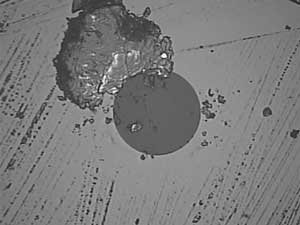 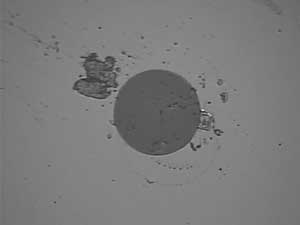
As you can see, the dirt is large compared to the size of the fiber (dark gray), and the core (not visible here) is only 9/125 of the overall diameter of the fiber! More on cleaning. See Product News below for links to vendors of fiber cleaning products.
See news about Fiber Optic Cleaning Videos on YouTube by ITW Chemtronics below.
Measurement Uncertainty: Everyone testing fiber optics should understand that every measurement has some uncertainty - whether you are measuring loss, length, wavelength, power, etc. Knowing that uncertainty is very important to interpreting the measurement. It's worthwhile to read and understand the issue of measurement accuracy covered in this page of the FOA Online Fiber Optic Reference Guide.
RETURN TO INDEX
Worth Reading or Watching:
What Is The FOA?
Hear FOA President Jim Hayes tell the FOA Story in a 2-part interview by Sound & Video Contractor Contributing Editor Bennett Liles. It tells about the FOA history, goals and achievements.
Part 1: http://svconline.com/podcasts/audio/fiber_optic_association_part1/index.html.
Part 2 http://svconline.com/podcasts/audio/inside-fiber-optic-association2-0924/index.html.
Networks Today: 80% on cable, 20% wireless, Networks Tomorrow: 20% on cable, 80% wireless
Dimension Data this week released its annual Network Barometer Report 2013, which evaluates the readiness of enterprise networks to support critical business operations. The announcement, made during the Cisco Live user conference in Orlando, Fla.

(The gentlemen looking at a bundle of copper cables must be illustrating the industry's nostalgia for old copper technology!)
You can download the Dimension Data report here.
How Is Fiber Manufactured?
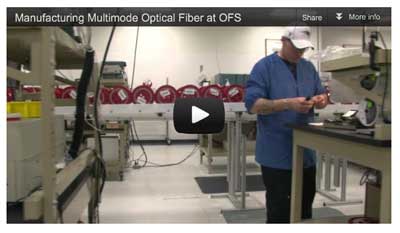
OFS invites you on a tour of their multimode fiber manufacturing facilities in this new 5-minute video. You will see their highly automated manufacturing operation in Sturbridge, Mass., including their patented MCVD preform fabrication process to fiber draw and final product testing. With a technological heritage dating back to AT&T and Bell Labs, OFS has been manufacturing high-quality multimode fiber since 1981.
Watch the video here.
Where Are The Jobs In Fiber Optics?
The August, 2012 FOA Newsletter presented a review of where we see the most active areas in fiber optics now and where the jobs seem to be most available. You can read this article here. If you are looking for a job, the FOA also has a web page on looking for jobs and a LinkedIn group for CFOTs where jobs can be posted,plus a jobs section in this newsletter.
More On Fiber Use In Wind And Solar Power
Craig Bowden, FOA Master Instructor at FiberNexxt in NH, presented a program at the New England Fiberoptic Council recently on fiber in wind power. His presentation is available for downloading here. It's full of good illustrations and photos that tell the story.
Want To Know Where Submarine Fiber Optic Cables Run?
There is a good map online by TeleGeography you can access here.
Confused By Standards?
You are not the only one! As Bob Metcalfe, co-inventor of Ethernet, once said at a conference "The wonderful thing about standards is we have so many to choose from!" But the Siemon Company, an active participant in standards activities for decades, has tried to give some order to this chaos with a new website Standards Informant where they cover the TIA, ISO /IEC and IEEE standards that affect cabling and networks. If you need to keep up with standards, sign up for their email newsletter too.
Benchmarking Fusion Splicing And Selecting Singlemode Fiber
We've been asked many times "How long does it take to splice a cable?" It's not a simple answer as it varies with the number of fibers in the cable and the work setup, including whether one or two techs are working at a job site. FOA Master Instructor Joe Botha of Triple Play in South Africa did his own analysis based on decades of experience both splicing cables and teaching others how to do it properly. This is one of the best analyses we have seen because Joe includes prep times as well as splicing times and differentiates between one tech and two techs working together. He adds some other tips on fusion splicing too. This should be mandatory reading for every tech and given to every student! Here is Joe's splicing analysis.
Joe also has an excellent writeup on how to choose singlemode fiber that helps understanding the different types of G.6xx fiber. Read it here.
And you will want to read Joe's report on splicing different types of SM fiber, including bend-insensitive (G.657) fiber. Read it here.
Videos on Firestopping: These free videos from UL and the International Firestop Council are good tutorials on firestopping. Go here to view the videos.
Micro-Trenching, Cable Removal
Nano-Trench offers products for micro (or I guess they call it nano-) trenching and their website is very informative. They also have Kabel-X, a method of extracting copper cables from old conduit. Both websites are informative and interesting. Watch this video on the cable removal process!
Free - Mike Holt's Explanation Of The US National Electrical Code (NEC) For Communications Cables
Mike Holt is the acknowledged expert of the US National Electrical Code (NEC). His books and seminars are highly praised for their ability to make a very complicated standard (that is in fact Code - law - in most areas of the US) easily understood. Part of the appeal is Mike's great drawings that make understanding so much easier. Mike makes Chapter 8 of his book available free. It covers communications cables, telephones, LANs, CATV and CCTV, for premises applications. Even if you live in a region or country where the NEC is not the law, you may find this interesting.
Download Mike's Chapter Here.
Fiber Optic Cleaning Videos on YouTube
ITW Chemtronics has three fiber optic cleaning videos on  covering Dry Cleaning, Wet-Dry Method, FiberWash and Combination Cleaning. They are good explanations of cleaning processes - the Wet-Dry is especially interesting. covering Dry Cleaning, Wet-Dry Method, FiberWash and Combination Cleaning. They are good explanations of cleaning processes - the Wet-Dry is especially interesting.
A Documentary Treasure on the History of the Internet
15 minutes of a rarely-seen BBC documentary demolish the myth that ARPAnet was inspired by nuclear war, and explain the far more intriguing truth.
http://www.technologyreview.com/blog/mimssbits/26719/?nlid=4433
Ensuring Distance Accuracy On OTDR Measurements
By JDSU.
Fiber Optic Safety Poster
We've had numerous requests to reprint our guidelines on safety when working with fiber optics, so we have created a "Safety Poster" for you to print and post in your classroom, worksite, etc. We suggest giving a copy to every student and installer.
RETURN TO INDEX
Webinars and Websites of Interest (Archives)

CI&M magazine often does webcasts on interesting topics in premises cabling. FOA President Jim Hayes has done several for them too. Here are the archives of all recent webcasts: http://www.cablinginstall.com/webcasts.html
Broadband Properties Webinar Archives

Lots of interesting webinars, mostly on FTTH. Go here.
Broadcast Engineering Magazine - Fiber Optic Testing
FOA President Jim Hayes presents an overview of fiber optic testing for all applications. Available on Demand. Sign up here.
OSP Magazine Webinars
OSP Magazine (OSP as in outside plant telco) is now offering a number of interesting webinars that cover fiber topics, including network design and specialized components. http://www.ospmag.com/events/web/
Multimode Fiber Characterization Launch Condition Considerations - new ap note from JDSU
JDSU Reference Guide to Fiber Optic Testing – Volume 2 Published
The second volume of the JDSU series on fiber optic testing has been published. Volume 1 focused on Basic Fiber testing and Volume 2 is geared toward fiber optic installers, project managers, telecom technicians and engineers who need to understand fiber networks. Volume 2 also covers Chromatic Dispersion, Polarization Mode Dispersion, Attenuation Profile and Fiber Link and Network Characterization. A 3rd volume, a glossary of fiber optic terms, is also available for download.
This is a "MUST HAVE" for all fiber optic techs. Download your free copies here.
We used this book as one of our references in creating a new page in the FOA Online Reference Guide on chromatic dispersion (CD) and polarization-mode dispersion (PMD).
Careers in Fiber Optics: Brian Smith. A 1998 book on fiber optic jobs is a bit dated, but a free overview is on Google Books and worth a look at it online.
Good Technical Websites
American Polywater (http://www.polywater.com/) has one of the best technical website for cable installers. Here is a rundown on some new material on their site.
Check out their website, especially “Videos,” “Engineer’s Corner” and “Calculators.” http://www.polywater.com/NNNBSL.pdf

" Heard on the Street" is a monthly online newsletter from Frank Bisbee of Communications Planning Corporation that covers the telecommunications and cabling businesses. Each month includes news from manufacturers, trade associations and professional societies like the FOA. You can read the current issue and back issues online.

JDSU has announced the See the Light webinar series, a four-part program designed for anyone involved in the installation, maintenance, and repair of fiber optic systems. It begins with fiber inspection and cleaning and then covers the basics of fiber testing. The webinar series then continues with the more advanced optical time-domain reflectometer (OTDR) and fiber local area network (LAN) testing challenges. More information on the series.
IGI is offering a series of webinars on topics of interest to those in the communications industry. You can join them live ir download from the archives. IGI WEBINAR ARCHIVES UP AND RUNNING - VISIT TELECOMBRIEFINGS.COM TO DOWNLOAD!
IGI, a major market research and technology reporting company (the "Active Optical Cables" below) is offering a a free one year subscription to one of our fiber optics newsletters to FOA members. All they have to do is to send IGI an e-mail stating which newsletter they would like to get. See http://www.igigroup.com/nl.html for a listing of IGI Newsletters.
RETURN TO INDEX
-
FOA Tech Topics -
A Fiber Optic Tester In Your Pocket? (See the video on  ) )
Yes! The camera in your cell phone is sensitive to infrared light - lots more than your eye - and can detect light in an optical fiber or from a transmitter. Chris Hillyer,CFOT/CFOS/I, Master Instructor, Northern California Sound & Communication JATC brought this to our attention.
 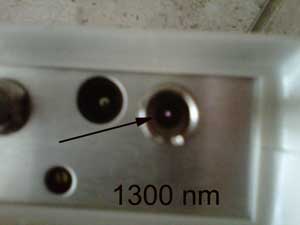
If you have an old cell phone, try it too. Our experience is that older cell phone cameras have better sensitivity at IR wavelengths than newer phones, so you may want to toss that old phone into the toolbox.
RETURN TO INDEX
Product News
Switch For Testing MTP/MPO Cables
Fibernext has introduced a portable switch for testing multifiber MTP/MPO connectors. You can also watch the YouTube video here.

Fiber In Water Pipes
The Atlantis Hydrotec System provides an innovative and cost effective way of running fibre optic cable through existing drinking water supply pipes, making fibre to the home (FTTH) or commercial premises simple, quick, cost effective and environmentally friendly.

The Atlantis Hydrotec System provides an innovative and cost effective way of running fibre optic cable through existing drinking water supply pipes, making fibre to the home (FTTH) or commercial premises simple, quick, cost effective and environmentally friendly. This patented and WRAS approved system is made up of specially designed fittings which are installed into the start and end locations of the supply pipes. Microduct is then installed between the two fittings creating a gas-tight environment in which fibre can be installed without coming into contact with the water supply. Read more.
Recycling Communications Cable
FOA was contacted by a company that recycles electronics communications equipment and cabling. CommuniCom recycles cable/metals/e-waste for Telcos and CATVs. They also recycle Fiber Optic Cable and associated Materials (the fiber scrap). And, they reclaim OSP abandoned copper cables (abandoned from road moves or FTTx growth). This is a huge part of our business. They do the work (permitting/locates/labor) for free and we revenue share back with our clients (telcos).
Contact Steve Maginnis
smaginnis@communicominc.com
www.communicominc.com
803.371.5436 (cell)

Micro-Trenching, Cable Removal
Nano-Trench offers products for micro (or I guess they call it nano-) trenching and their website is very informative. They also have Kabel-X, a method of extracting copper cables from old conduit. Both websites are informative and interesting. Watch this video on the cable removal process!
Protecting Pedestals From Rodents
Pedestals and underground vaults can be damaged by rodents who come up through the base and damage cables. Uraseal "Drain N'Seal" foam deters mice from taking up residence in your pedestals. They have some good videos on using their product.
Used Test Equipment – Buy or Sell
http://www.testequipmentconnection.com/
Have you read the FOA Tech Topics on Cleaning?
As much as 70% of the problems associated with deploying fiber result from something as simple as dirty connectors according to JDSU. Telephony Online.
US Conec's videos on cleaning fibers - show's the results of proper cleaning.
Westover
- AFL
ITW Chemtronics
Cleantex Alco Pads
MicroCare
Seiko-Giken
- RETURN TO INDEX
FTTH Notes:
Many States In the US Restrict Municipal Networks
As reported in the website "Community Broadband Networks," many municipalities are creating their own networks, including FTTH like Chattanooga and Clarksville, TN, etc. But in 19 of the US states, there are laws that handicap municipalities or outright ban their offering "telecom" services. (See the list of laws compiled by Optica here.) Obviously, these laws were passed to protect the (usually monopoly) telecom and CATV providers who do not want competition. But they also make it difficult or impossible for many areas to get broadband.
Does anybody know if these laws prohibit a municipality from building a fiber network and then leasing it to an Internet service provider? Obviously, FTTH needs good lawyers too.
-
FTTH in MDUs (Multiple Dwelling Units)
When we talk about FTTH, we often assume we are installing the fiber to a “home” where it terminates in a optical line terminal (OLT) and services (voice, data and video) are delivered inside the subscriber’s "home." But since we may have detached single-family homes, row houses or living units in a large building, the situations can be quite different, requiring different architectures and installation practices. To clarify the options for fiber in MDUs, FOA has created a new page in our FTTx section of the FOA Guide to explain the options.

FOA Guide: FTTH in MDUs
Google Map Shows Worldwide FTTx Projects
One of the better sites to track FTTx projects is this Google maps application that shows projects on a world map with details on the project.

Click on the map above or here to view the interactive web map.
Testing FTTH
JDSU shows how to test a PON with an OTDR: http://www.jdsu.com/other-literature/PON-OTDR_fop_an_ae.pdf
-
- Want To Learn More About FTTx?
- The FOA has created a special FTTx resources section of our website with a FTTx links page with lots of links to news, market reports, technical articles and vendor technical and product information. Here is a great place to start learning more about FTTx.
- FOA's CFxT FTTx Certification Program Explained
- Read the Broadband Properties article about the FOA FTTx certification program. Read the article about FOA President Jim Hayes being honored for his work promoting FTTH.
|
- RETURN TO INDEX
-
Where Are The Jobs In Fiber Optics?

The FOA was chartered to "promote professionalism in fiber optics through education, certification and standards." Our focus on creating a professional workforce to properly design, install, maintain and repair communications network infrastructure has led us to work with groups in many different areas of technology that use fiber optics, way beyond the basic telecom applications that most of us think of first. FOA has probably worked with most of the potential applications of fiber optics, but we're always learning about new ones!
In addition, we get lots of calls and emails from our members looking for information about where the jobs are and how to train for them. FOA has created three ways to help you find jobs, train for them and apply for them.
Where Are The Jobs In Fiber Optics?
FOA has created a 20 minute YouTube video that talks about all the applications for fiber optics, what jobs are involved and the qualifications for the workers in the field. Besides telecom and the Internet, we cover wireless, cable TV, energy, LANs, security, etc. etc. etc. It's a quick way to get an overview of the fiber optic marketplace and we give you an idea of where the opportunities are today.
Watch the new FOA YouTube Video: Where Are The Jobs In Fiber Optics?
What Training Is Needed For The Jobs In Fiber Optics?
As you will learn from the video described above, the jobs in fiber optics are quite diverse. FOA has investigated these jobs to understand the needs of workers for those jobs and, when necessary, create curriculum and certifications to properly train workers. For example, the FOA FTTx certification was developed at the request of Verizon who needed specialized installers for their FiOS program. Now we are working with the industry on the OLAN (Optical LAN) program (see below).
We have summarized the jobs and required training in a new web page that has two uses - 1) If you have FOA certifications, what jobs are you specifically qualified for? - 2) If you are working in a specialized field or want to get a job in that area, what training and certifications will qualify you for those jobs?
What Training And Certifications Are Needed For Jobs In Fiber Optics?
How To Find And Apply For Jobs In Fiber Optics
We get many questions from CFOTs, students at FOA-Approved schools and others contemplating getting into the fiber optic business regarding jobs in fiber optics - and how to find them - so we’ve created a new web page to share some information we've gathered about jobs in our industry. The information is designed to help you understand what jobs are available in fiber optics, how to find them and apply for them.
If you are looking for a job in fiber optics, here is the FOA's guide to jobs.
We hope you find this useful. FOA tries to find new to increase the professionalism in our industry and helping qualified people find jobs is our highest priority - read the article below to see why! If you have feedback on how we can help you and our industry, contact us at info@thefoa.org.
Join FOA on 
A list of 10 ways to get your resume noticed, from Marketplace on NPR
Job Openings
FIBER OPTIC SPLICERS (12/13)
Applicants should have experience in splicing fiber optic cables in the air, underground, and indoors. Additionally, experience terminating fiber with mechanical connectors, epoxied connectors, and fused on pigtails. Must have attention to detail when setting up splice locations, termination points, and general fiber optic construction. Prefer experience working in a production based environment for small to large projects and testing for acceptance, trouble identification, and fiber characterization. Additional preference given to applicants with experience using the latest equipment and that can adapt their experience to Spligitty Fiber Optic Services’ preferred processes.
The ideal applicant(s) will have a good work ethic, be hard working, and willing to learn. Applicant must have a standard driver's license, a clean driving record, and pass a pre-employment drug test. Travel may be required in some areas.
(Be sure to remind them if you have a CFOT!)
Wage: DOE
Positions available as listed:
(2) In Washington
(2) In Montana
(2) In the Greater Salt Lake City area, Utah
Apply by emailing Michael Hill at mhill@spligitty.com. Please provide your resume and a contact phone number.
Optical Connectors - Principal Engineer- (9/13)
Position Overview:
The Advanced Manufacturing Technology (AMT) group which supports and develops leading edge manufacturing technologies and plays a central R&D role within the company, is seeking an enthusiastic, innovative, and goal-oriented individual. The candidate should be proactive in problem solving and possesses technical leadership and communication skills that will lead and transition new technologies from the laboratory to the business units to help maintain and grow my client as the global leader in connectivity. The position is in Harrisburg, PA.
Responsibilities & Qualifications:
Work with business units development engineers and manufacturing organizations to transition successful technology to large-scale manufacturing and the end-user market
Ability to be a technical expert, lead projects or serve as a team member of complex, large, or high impact projects
Develop creative and innovative approaches for manufacturing processes
Troubleshoot technical problems, determine and execute resolution plans
Create and/or contribute to project scoping, planning, budgeting and schedules
Ability to perform proficiently in all phases of the project from concept to transfer
Works on technically complex and high impact projects and deliverables, where ingenuity and basic business understanding is required. Applies advanced/expert knowledge of specialized discipline(s) and methods to support internal/external customer needs
Independently researches broad, diverse, complex issues outside technical capability; selects most efficient methods/techniques to achieve objectives. Simultaneously handles multiple, demanding, unstructured assignments and solves complex high impact problems requiring expert specialized skill, multi-disciplinary knowledge, and basic business understanding. Responsibility includes definition, completion, technical quality, and securing consistency across assigned area(s)
Applies knowledge in a broad range of topics within technical discipline, reflecting in-depth knowledge of 1-2 sub-specialty areas
Demonstrates advanced/expert knowledge in a single or multi-disciplinary area, and balances constraints/opportunities of 2-3 adjacent technical disciplines with primary technical area(s)
Assist in developing long-range plans for incorporating new processes and selecting new equipment
Keep-up-to date with latest manufacturing technologies through conducting independent literature searches, conferences, networking and implement these innovative technologies within the organization
Use engineering principles in assessing viability of new technologies
Provide recommendations to internal businesses about innovative manufacturing technologies that will be implemented for production
Transfer new processes from the laboratory to the manufacturing environment and establishing robust high quality manufacturing principles
Qualifications required:
Ph.D., preferably in Polymer Engineering or Mechanical Engineering, with exceptional academic achievements or relevant work experience, or an M.S. degree with work experience, and be familiar with mechanical design and injection molding methodologies.
Candidates with prior knowledge in fiber optics connector manufacturing are strongly encouraged to apply.
Ability to communicate effectively throughout all levels within the organization. Excellent multi-tasking and organizational skills
Proficient in Microsoft word software including but not limited to: Outlook, Word, Excel, PowerPoint, and Project
Preferred CAD experience with AutoCAD, Pro/E, or SpaceClaim
Preferred FEM experience such as ANSYS, Moldflow
Preferred statistical software experience with Minitab
Strong analytical thinker with excellent problem solving skills
Knowledgeable and hands on experience in injection molding or other plastics related processing (extrusion, thermoforming, compression, blow molding, compounding), secondary operations, value added operations, automation, assembly, mold design, utilization of high end precision machining equipment, additive manufacturing
Preferred characterization experience or knowledge of AFM, SEM
Preferred material analysis experience or knowledge of DSC, TGA, DMA
Ability to work independently with minimal supervision and guidance
Demonstrate ability to work within a team environment
Solid fundamental understanding of: polymer structure property relationships; polymer properties in regarding to physical, electrical, chemical and other properties; heat transfer of various materials; fluid flow of polymers
Willingness to travel domestically and internationally.
NOTE:
The MUST HAVES for this position are:
PhD degree or MS degree
Preferably in Polymer Engineering but also Mechanical Engineers will be considered
Experience with injection molding process
Experience with optical connector molding
Experience with polymer characterization techniques
Solid understanding of polymer structure-properties relationships
Some design experience (for example design for manufacturability)
IF you or a friend/colleague are interested in one of these (or similar) great job opportunities, please respond with resume and cover-letter explaining why you are a fit and for which position. Resume submissions, referrals and suggestions are always welcomed.
Best Regards,
Nicholas Meyler
GM/President, Technology
Wingate Dunross, Inc.
ph (818)597-3200 ext. 211
<nickm@wdsearch.com>
Field Application Engineer – Optics (Menlo Park, CA) (9/13)
The Data Communications business unit of my client has an opportunity for a Field Application Engineer in Menlo Park, CA to support a key customer at their location. The business unit has determined that, for key customers, having knowledgeable engineering presence on-site is critical to long-term success in supporting the customers’ product and design needs and in advancing the Company’s interests.
The resident engineer will serve as a technical resource for customers’ engineers and program / platform managers by providing technical expertise, design work, product application information, and general support for strategic customers. The resident engineer will be a significant interface between Company’s sales and engineering organizations and customers.
Key Job Responsibilities:
• Be the initial point of contact for customer’s local engineering group
• Function as the technical interface between the customer’s engineers and the engineering community on all existing products as well as focus on new product development opportunities
• Actively contribute to new product development opportunities for company at the customer with the ability to provide conceptual design
• Interact directly with customer account(s) on a daily basis and coordinate the deliverables related to customer projects including new products, modifications to existing products, test studies, signal integrity modeling, and any other development efforts
• Establish relationships with key customer engineering contacts and decision makers
• Gain a solid understanding of customer’s product set and future roadmap
• Gain a solid understanding of products and future roadmap
• Use VOC (Voice of Customer) tools to understand the accounts’ technology, strategic direction, and electronic connectivity needs. Communicate these needs to internal Electronics teams to initiate projects
• Support a cross-functional, global team specific to the customer. The team may consist of a Program Manager, Quality Engineering, Logistics, Procurement, Operations, and Sales.
• Penetrate customers’ design cycle to be involved in the early stages of new product / platform planning
• Work closely with internal engineering teams to insure that they are meeting the customers’ needs and be a conduit to the customer
• Represent and be an advocate for the customer.
• Support product & process qualifications
• Support existing applications and products including tolerance analysis, application evaluation, and testing
The ideal candidate should have the following qualifications:
• BS degree in Engineering required (Electrical / Mechanical / Systems discipline preferred)
• Experience with optical transceivers and testing methods / equipment (either as a designer, user, qualifier, etc)
• Experience with both single mode and multimode transceivers
• Familiarity with Ethernet, infiniband, and other high speed data protocols / standards
• Experienced with 10G and above data rates
• Familiarity with structured optical cabling
• Familiarity with standard optical connects (mpo, LCD, sc, FC)
• Demonstrated ability to document customer product concept in variety of electronic formats
• Proficient in product data management tools
• Demonstrated ability to provide effective project leadership
• Demonstrated ability to organize and prioritize
• Strong interpersonal & negotiating skills
• Excellent oral and written communication skills demonstrated by the ability to communicate across all levels within and outside of the organization
• Computer proficient including 3D Design Applications
• Ability and willingness to travel as required, mainly regionally
• Ability and willingness to be a remote-based employee with limited personal interaction with immediate supervisor
• Successful candidates will have strong ability to work independently
• Outstanding networking, influencing, and listening skills
• Additional industry based skills a benefit:
• At least 4 – 8 years of engineering experience in connector knowledge
• Knowledge of general manufacturing processes of stamping, molding, plating, and automated product assembly desired
• Experience in development engineering and participation in full product development cycle
• Prefer candidates with some knowledge of electronics components, preferably in one or more of our product lines (connectors, electronics relays, wire & cable)
NOTES (new information): There are two scenarios for this Field Applications position. We will certainly consider any highly-qualified designers who have optical transceiver and backplane experience, who wish to become field applications/customer-focused engineers. Also, we would consider junior Optical Engineers/Electrical Engineers who have recently graduated or are Post-Docs. Here are the outlines of the two categories we are looking for:
Contact:
Nicholas Meyler
GM/President, Technology
Wingate Dunross Associates, Inc.
ph (818)597-3200 ext. 211
nickm@wdsearch.com
Construction Company looking for a few good people. (Plainfield, IN) (9/13)
CSU Inc. is looking for the following applicants. Individuals with experience in Horizontal Directional Drilling, Fiber Optics, Telecommunications or Water Main Installations. Top candidates have experience with one of the following skills: HDD Locating, Operation of a Directional Drill, Drop Plow, Vac-Truck, Backhoe, Mini Excavator or General Labor. Class A CDL a plus. We are also accepting applications for candidates that have a strong work ethic and would like to work in a fast paced environment. We offer Matching Retirement, 100% Paid Medical Premiums, Paid Vacation, Holidays and Incentive Plan. If this sounds like something you would be interested in please call 317-972-0802, go to www.csucontracting.com and fill out an online employment application or fax your resume to 317-839-8597. We are located at 3919 Clarks Creek Road, Plainfield IN.
JOB TITLE: FIELD SUPERINTENDENT
POSTING DATE: 9/9/2013
WORK HOURS: THIS IS A FULL-TIME SALARIED POSITION
REPORTS TO: OPERATIONS MANAGER
JOB SUMMARY
This position is responsible for planning, laying out, participating in, and supervising work on multiple job sites. This position performs supervisory responsibilities from pre-construction meetings to final walk outs. This position assists with the scheduling, supervision of field crews and communication with the project managers of their designated projects. The Superintendent is a working supervisor, meaning non-supervisory time may be dedicated towards Foreman activities.
ESSENTIAL JOB FUNCTIONS
· Travels to job sites to ensure work is progressing to schedule and acts as a referral point for Foremen when questions arise.
· Assists the Operations Manager to develop an effective plan and schedule for completion of project following a logical pattern for utilization of labor, material, and equipment in conjunction with construction/GC schedule.
· Coordinates work of employees working on various phases of projects.
· Forecasts, oversees, and actively supervises all assigned labor efforts, equipment & material requirements.
· Tracks timeline of jobs to stay on schedule.
· Reports to the Operations Manager about progress and any necessary modifications of plans that seem indicated, including any out-of-scope work is not completed until a change order has been issued.
· Communicates regularly with project managers, customers and engineers.
· Ensures project documents (as-builds) are complete, current, and stored properly.
· Ensures all work is completed to applicable code in a safe manner.
· Attends coordination, planning, & progress meetings on-site as required.
· Plans and lays out work from verbal and written instructions; oversees the work of CSU personnel.
· Other duties as assigned.
Work under pressure and coordinate numerous activities and groups of people who need to cooperate to achieve maximum efficiency.
Contact:
David Staten
Business Development
INC.
Utility Contractor
3919 Clarks Creek Road
Plainfield, Indiana 46168
Office: 317-839-8588
Fax: 317-839-8597
Cell: 317-612-4443
david@csucontracting.com
www.csucontracting.com
~WBE Construction Contractor~
FOA lists jobs and contracting opportunities on our LinkedIn groups. CFOTs are invited to join.
Do listings in the FOA Newsletter Work? Here's feedback:
"We did great! We have over 15 interviews next week."
"Your newsletter generated a significant number of applicants and we have filled the position."
RETURN TO INDEX
-
|








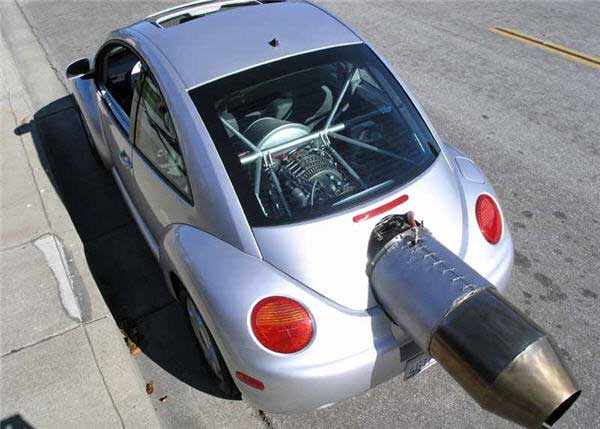














 What's Happening @ FOA
What's Happening @ FOA Corporate Memberships
Corporate Memberships






























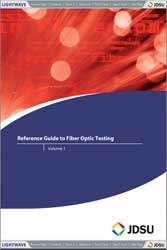 JDSU offers a free download of their Testing Guide from the Lightwave website. This is one great book which explains some basic fiber technology, but the real value is the last half which deals with OTDR testing. Not only does it give the usual info, but it covers important topics like measurement uncertainties and anomolies like ghosts and gainers.
JDSU offers a free download of their Testing Guide from the Lightwave website. This is one great book which explains some basic fiber technology, but the real value is the last half which deals with OTDR testing. Not only does it give the usual info, but it covers important topics like measurement uncertainties and anomolies like ghosts and gainers.
